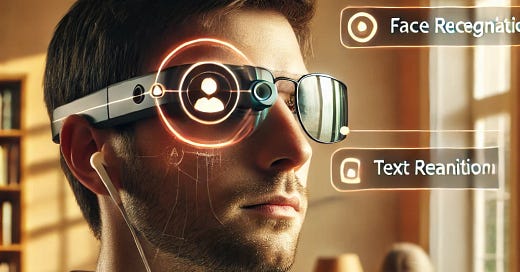How could a lightweight pair of AI-powered glasses revolutionize independence for millions of visually impaired individuals worldwide?
The article "AIris: An AI-powered Wearable Assistive Device for the Visually Impaired" by Dionysia Danai Brilli, Evangelos Georgaras, Stefania Tsilivaki, Nikos Melanitis, and Konstantina Nikita presents a groundbreaking wearable solution designed to enhance the autonomy and spatial awareness of visually impaired individuals. The AIris device combines a sleek eyewear-mounted camera system with advanced natural language processing and machine learning to provide real-time auditory descriptions of a user's surroundings. By using a distributed architecture, the system captures high-resolution visual data locally through a microcomputer (Raspberry Pi), which processes preliminary data and transmits it to a powerful central server for in-depth analysis. This ensures a lightweight, comfortable wearable experience while maintaining high processing accuracy and low latency.
At the heart of AIris’s capabilities are several key modules that enable users to perform complex tasks seamlessly. The face recognition module allows users to identify familiar people and add new faces to their database, enhancing social interactions and personalizing their experience. The scene description module provides a verbal overview of the immediate environment, identifying key elements such as objects, obstacles, and pathways, helping users navigate both indoor and outdoor spaces with greater confidence. For interaction with written content, the text reading module utilizes optical character recognition (OCR) to convert text from signs, documents, and labels into spoken words, granting access to essential information. Additionally, the object recognition module helps users identify items of interest, while the money counting module differentiates and tallies currency for financial independence. Complementing these core features, the note-taking module enables users to record verbal notes, organizing their thoughts and reminders efficiently. The barcode scanning module further supports daily activities by decoding product information, enabling users to independently identify items such as groceries or household supplies.
The hardware design of AIris emphasizes both functionality and comfort. The eyewear's lightweight 3D-printed frame supports the camera and earphones without obstructing the user’s vision or causing discomfort during extended use. The microcomputer is placed in the user's pocket to minimize the weight on the eyewear. Bluetooth earphones provide audio feedback without diminishing the user's ability to hear ambient sounds, ensuring situational awareness.
AIris’s voice command interface uses advanced natural language processing to make the device intuitive and user-friendly. Users can issue commands in natural language, requesting descriptions, identifying objects, or initiating text reading with ease. The integration of speech-to-text and text-to-speech capabilities creates a smooth conversational flow between the user and the device. In preliminary trials with visually impaired participants, the AIris prototype demonstrated significant potential, helping users perform tasks such as navigating spaces, reading text, and identifying people and objects. Participants noted that the device fostered a sense of reassurance and independence, although feedback highlighted areas for improvement, such as reducing latency and enhancing ergonomic design for prolonged use.
The authors highlight the system's adaptability and potential for future enhancements. Since the computationally intensive machine learning models operate on the cloud, the AIris system is highly flexible and can be updated with the latest advancements in artificial intelligence. Future iterations may incorporate large vision-language models and generative AI to enable more nuanced scene descriptions, personalized interactions, and improved context-awareness. The AIris project represents a transformative leap in assistive technology, blending cutting-edge AI with thoughtful design to offer visually impaired users an unprecedented level of independence and connectivity. The authors also stress the importance of collaboration with the visually impaired community to co-create features and refine the system, ensuring that future developments align with user needs and preferences.
In conclusion, AIris stands out as an innovative and practical solution that leverages artificial intelligence to bridge accessibility gaps. By converting complex visual data into actionable auditory feedback, the device not only aids with everyday tasks but also enhances the quality of life for visually impaired individuals. The ongoing development of AIris underscores the potential for wearable AI to transform assistive technology and foster greater inclusion and empowerment.




